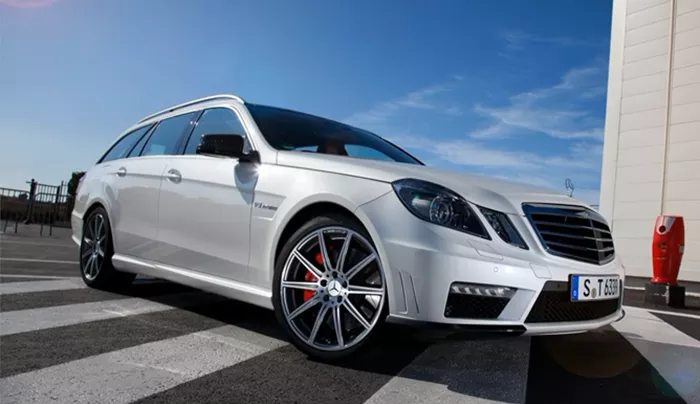Luxury SUVs like the Porsche Cayenne, BMW X5, and Mercedes GLE dominate the market today. They offer plenty of space and the ability to park boldly—sometimes even with two wheels on the curb when mall parking is scarce. However, there is a cooler option available. Thanks to the engineers in Stuttgart, Germany, you can have the comfort and utility of an estate car without sacrificing style or sporty performance.
This option is the AMG wagon. It is the last of its kind—an estate that can carry a mountain bike or surfboard and still race any sports car at a stoplight. If you had to pick between a powerful SUV or a hot estate, the Mercedes E 63 AMG wagon would be our top choice. Here’s why.
People often choose big SUVs because they seem practical. The “Sports Utility Vehicle” name suggests a rugged, versatile car for active lifestyles. But two things have changed since SUVs became popular in the late 1990s. First, SUVs are less about utility and more about size and image. They have decent space but are mostly large, sporty cars. Second, modern wagons have evolved. They now blend practicality with sportiness and luxury, making them excellent people carriers.
Take the previous generation Mercedes E-Class Estate, known as the S212, as an example. The E 63 AMG variant of this model packed the most advanced technology and sporty DNA from Stuttgart.
A Strong, Square Design for the S212
The S212 came shortly after Mercedes revealed the W212 sedan, the fourth-generation E-Class, at the 2009 Detroit Auto Show. The sedan stood out with a sharper, squarer look. Details like twin rectangular headlights and a bulge above the rear wheels gave it a powerful stance.
The estate version arrived in 2010. It featured a gently sloping roofline, avoiding the awkward, stretched shapes of older wagons. The design gave the rear glass area a bold and forceful appearance, even on standard models.
The S212 lineup started with common engine options: two diesels—a 2.2-liter inline-4 in two power levels and a 3.0-liter V6—and multiple gasoline engines. These included turbocharged 1.8- and 2.0-liter four-cylinders, and a 3.0-liter V6 for higher trims.
By 2011, the 3.0-liter V6 was replaced by a more powerful 3.5-liter V6. The top petrol model, the E 500, initially had a 5.5-liter V8. After the 2013 facelift, this was swapped for a 4.7-liter turbocharged V8, known as the E 550 in some markets. The hybrid version combined the 3.5-liter V6 with an electric motor.
When it came to the high-performance AMG models launched in 2010, Affalterbach started with a 6.2-liter V8 for both the sedan and wagon. The facelift in 2011 introduced a twin-turbo 5.5-liter V8 that was more powerful and efficient. In the U.S., the E 63 wagon was only sold as the AMG S model, featuring a Performance Package boosting power to 550 horsepower and a top speed of 186 mph. All E 63 models came standard with the 4Matic all-wheel-drive system.
The facelifted AMG S212 is the model to get. Although horsepower remained similar, the twin-turbo V8’s torque made it far more responsive. With 590 lb-ft of torque delivered smoothly from 1,750 to 5,250 rpm, it was easier to drive than the older 6.2-liter V8. The permanent 4×4 traction and low center of gravity gave the wagon excellent handling.
Why the Estate Beats the SUV in Practicality and Performance
SUVs have a fundamental design flaw: a high center of gravity. Built to clear obstacles, they have higher ground clearance and sit tall. While modern SUVs have evolved, they still struggle with body roll and understeer on sharp turns.
An estate with a powerful V8 offers a better driving experience. It sits closer to the ground, reduces body roll, and has a lower center of gravity. This makes it faster and more agile through corners. Simply put, physics favors estates over SUVs for sporty driving.
The E 63 AMG estate came with low-profile tires, a wider front track, a stiffened suspension, and a redesigned front axle. It also featured electronic damping with three settings and rear air suspension to keep the ride smooth, even when loaded. The cargo space was huge—1,950 liters—with the “Easy-pack” system for folding floors and adjustable loading levels. The rear seats split and folded, and the tailgate opened and closed electronically.
This made the E 63 Estate as practical as any SUV, if not more so. Its low height made loading heavy or bulky items easy. Inside, it comfortably seated five people.
The powerful V8 engine worked with a seven-speed automatic transmission. Paddle shifters let drivers choose gears manually. There were four driving modes and a launch control feature. Gear change speeds could be set in three levels.
Reviews praised the E 63 AMG Estate’s sharp handling and powerful acceleration. MotorTrend called it “a greedy girl who flits out of corners to gobble up straightaways with gusto.” But it also noted a caution: “Approach a turn too fast or brake too late, and the electronic stability control will cut power, showing a flashing warning until the car regains control.”

